
CY7C1345G
4-Mbit (128K x 36) Flow Through Sync SRAM
Cypress Semiconductor Corporation • 198 Champion Court • San Jose, CA 95134-1709 • 408-943-2600
Document Number: 38-05517 Rev. *E Revised July 15, 2007
Features
■ 128K x 36 common IO
■ 3.3V core power supply (V
DD
)
■ 2.5V or 3.3V IO supply (V
DDQ
)
■ Fast clock-to-output times
❐ 6.5 ns (133 MHz version)
■ Provide high performance 2-1-1-1 access rate
■ User selectable burst counter supporting Intel Pentium inter-
leaved or linear burst sequences
■ Separate processor and controller address strobes
■ Synchronous self-timed write
■ Asynchronous output enable
■ Available in Pb-free 100-Pin TQFP package, Pb-free and
non-Pb-free 119-Ball BGA package
■ ZZ Sleep Mode option
Functional Description
The CY7C1345G is a 128K x 36 synchronous cache RAM
designed to interface with high speed microprocessors with
minimum glue logic. The maximum access delay from clock rise
is 6.5 ns (133 MHz version). A two-bit on-chip counter captures
the first address in a burst and increments the address automat-
ically for the rest of the burst access. All synchronous inputs are
gated by registers controlled by a positive edge triggered Clock
Input (CLK). The synchronous inputs include all addresses, all
data inputs, address pipelining Chip Enable (CE
1
), depth
expansion Chip Enables (CE
2
and
CE
3
), Burst Control inputs
(ADSC
, ADSP,
and
ADV), Write Enables
(
BW
x
,
and BWE
), and
Global Write (GW
). Asynchronous inputs include the Output
Enable (OE
) and the ZZ pin.
The CY7C1345G enables either interleaved or linear burst
sequences, selected by the MODE input pin. A HIGH selects an
interleaved burst sequence, while a LOW selects a linear burst
sequence. Burst accesses are initiated with the Processor
Address Strobe (ADSP
) or the cache Controller Address Strobe
(ADSC
) inputs.
Addresses and chip enables are registered at rising edge of
clock when either Address Strobe Processor (ADSP
) or Address
Strobe Controller (
ADSC
) is active. Subsequent burst addresses
are internally generated as controlled by the Advance pin (ADV
).
The CY7C1345G operates from a +3.3V core power supply
while all outputs operate with either a +2.5 or +3.3V supply. All
inputs and outputs are JEDEC standard JESD8-5 compatible.
For best practice recommendations, refer to the Cypress appli-
cation note AN1064, SRAM System Guidelines.
Selection Guide
Parameter 133 MHz 100 MHz Unit
Maximum Access Time 6.5 8.0 ns
Maximum Operating Current 225 205 mA
Maximum Standby Current 40 40 mA

CY7C1345G
Document Number: 38-05517 Rev. *E Page 2 of 20
Logic Block Diagram
ADDRESS
REGISTER
BURST
COUNTER
AND LOGIC
CLR
Q1
Q0
ENABLE
REGISTER
SENSE
AMPS
OUTPUT
BUFFERS
INPUT
REGISTERS
MEMORY
ARRAY
MODE
A
[1:0]
ZZ
DQ s
DQP
A
DQP
B
DQP
C
DQP
D
A0, A1, A
ADV
CLK
ADSP
ADSC
BW
D
BW
C
BW
B
BW
A
BWE
CE1
CE2
CE3
OE
GW
SLEEP
CONTROL
DQ
A
,
DQP
A
BYTE
WRITE REGISTER
DQ
B
,
DQP
B
BYTE
WRITE REGISTER
DQ
C
,
DQP
C
BYTE
WRITE REGISTER
BYTE
WRITE REGISTER
DQ
D
,
DQP
D
BYTE
WRITE REGISTER
DQ
D
,
DQP
D
BYTE
WRITE REGISTER
DQ
C
,
DQP
C
BYTE
WRITE REGISTER
DQ
B
,
DQP
B
BYTE
WRITE REGISTER
DQ
A
,
DQP
A
BYTE
WRITE REGISTER

CY7C1345G
Document Number: 38-05517 Rev. *E Page 3 of 20
Pin Configurations
100-Pin TQFP Pinout
A
A
A
A
A
1
A
0
NC/72M
NC/36M
V
SS
V
DD
NC/9M
A
A
A
A
A
A
DQP
B
DQ
B
V
DDQ
V
SSQ
DQ
B
DQ
B
DQ
B
DQ
B
V
SSQ
V
DDQ
DQ
B
DQ
B
V
SS
NC
V
DD
DQ
A
DQ
A
V
DDQ
V
SSQ
DQ
A
DQ
A
DQ
A
DQ
A
V
SSQ
V
DDQ
DQ
A
DQ
A
DQP
A
DQP
C
DQ
C
DQ
C
V
DDQ
V
SSQ
DQ
C
DQ
C
DQ
C
DQ
C
V
SSQ
V
DDQ
DQ
C
DQ
C
NC
V
DD
NC
V
SS
DQ
D
DQ
D
V
DDQ
V
SSQ
DQ
D
DQ
D
DQ
D
DQ
D
V
SSQ
V
DDQ
DQ
D
DQ
D
DQP
D
A
A
CE
1
CE
2
BW
D
BW
C
BW
B
BW
A
CE
3
V
DD
V
SS
CLK
GW
BWE
OE
ADSP
A
A
1
2
3
4
5
6
7
8
9
10
11
12
13
14
15
16
17
18
19
20
21
22
23
24
25
26
27
28
29
30
31
32
33
34
35
36
37
38
39
40
41
42
43
44
45
46
47
48
49
50
80
79
78
77
76
75
74
73
72
71
70
69
68
67
66
65
64
63
62
61
60
59
58
57
56
55
54
53
52
51
100
99
98
97
96
95
94
93
92
91
90
89
88
87
86
85
84
83
82
81
BYTE A
BYTE C
A
ADV
ADSC
ZZ
MODE
NC/18M
BYTE B
DQ
B
BYTE D
CY7C1345G

CY7C1345G
Document Number: 38-05517 Rev. *E Page 4 of 20
119-Ball BGA Pinout
Pin Configurations (continued)
2
345671
A
B
C
D
E
F
G
H
J
K
L
M
N
P
R
T
U
V
DDQ
NC/288M
NC/144M
DQP
C
DQ
C
DQ
D
DQ
C
DQ
D
AA AA
ADSP
V
DDQ
CE
2
A
DQ
C
V
DDQ
DQ
C
V
DDQ
V
DDQ
V
DDQ
DQ
D
DQ
D
NC
NC
V
DDQ
V
DD
CLK
V
DD
V
SS
V
SS
V
SS
V
SS
V
SS
V
SS
V
SS
V
SS
NC/576M
NC/1G
NC
NC
NCNCNCNC
NC/36MNC/72M
NC
V
DDQ
V
DDQ
V
DDQ
AAA
A
CE
3
AA
A
AA
A
A0
A1
DQ
A
DQ
C
DQ
A
DQ
A
DQ
A
DQ
B
DQ
B
DQ
B
DQ
B
DQ
B
DQ
B
DQ
B
DQ
A
DQ
A
DQ
A
DQ
A
DQ
B
V
DD
DQ
C
DQ
C
DQ
C
V
DD
DQ
D
DQ
D
DQ
D
DQ
D
ADSC
NC
CE
1
OE
ADV
GW
V
SS
V
SS
V
SS
V
SS
V
SS
V
SS
V
SS
V
SS
DQP
A
MODE
DQP
D
DQP
B
BW
B
BW
C
NC V
DD
NC
BW
A
NC
BWE
BW
D
ZZ
A

CY7C1345G
Document Number: 38-05517 Rev. *E Page 5 of 20
Pin Definitions
Name IO Description
A0, A1, A Input
Synchronous
Address Inputs Used to Select One of the 128K Address Locations. Sampled at the rising edge
of the CLK if ADSP or ADSC is active LOW, and CE
1
,
CE
2
, and
CE
3
are sampled active. A
[1:0]
feed
the two-bit counter.
BW
A,
BW
B
BW
C
, BW
D
Input
Synchronous
Byte Write Select Inputs, Active LOW. Qualified with BWE to conduct byte writes to the SRAM.
Sampled on the rising edge of CLK.
GW Input
Synchronous
Global Write Enable Input, Active LOW. When asserted LOW on the rising edge of CLK, a global
write is conducted (ALL bytes are written, regardless of the values on BW
[A:D]
and BWE).
BWE
Input
Synchronous
Byte Write Enable Input, Active LOW. Sampled on the rising edge of CLK. This signal is asserted
LOW to conduct a byte write.
CLK Input Clock Clock Input. Used to capture all synchronous inputs to the device. Also used to increment the burst
counter when ADV
is asserted LOW, during a burst operation.
CE
1
Input
Synchronous
Chip Enable 1 Input, Active LOW. Sampled on the rising edge of CLK. Used in conjunction with
CE
2
and CE
3
to select or deselect the device. ADSP is ignored if CE
1
is HIGH. CE
1
is sampled only
when a new external address is loaded.
CE
2
Input
Synchronous
Chip Enable 2 Input, Active HIGH. Sampled on the rising edge of CLK. Used in conjunction with
CE
1
and CE
3
to select or deselect the device. CE
2
is sampled only when a new external address is
loaded.
CE
3
Input
Synchronous
Chip Enable 3 Input, Active LOW. Sampled on the rising edge of CLK. Used in conjunction with
CE
1
and CE
2
to select or deselect the device. CE
3
is sampled only when a new external address is
loaded.
OE Input
Asynchronous
Output Enable, asynchronous Input, Active LOW. Controls the direction of the IO pins. When
LOW, the IO pins act as outputs. When deasserted HIGH, IO pins are tri-stated and act as input data
pins. OE is masked during the first clock of a read cycle when emerging from a deselected state.
ADV
Input
Synchronous
Advance Input Signal, Sampled on the Rising Edge of CLK. When asserted, it automatically incre-
ments the address in a burst cycle.
ADSP Input
Synchronous
Address Strobe from Processor, sampled on the rising edge of CLK, Active LOW. When
asserted LOW, addresses presented to the device are captured in the address registers. A
[1:0]
are
also loaded into the burst counter. When ADSP
and ADSC are both asserted, only ADSP is recog-
nized. ASDP
is ignored when CE
1
is deasserted HIGH.
ADSC
Input
Synchronous
Address Strobe from Controller, sampled on the rising edge of CLK, Active LOW. When
asserted LOW, addresses presented to the device are captured in the address registers. A
[1:0]
are
also loaded into the burst counter. When ADSP
and ADSC are both asserted, only ADSP is recog-
nized.
ZZ Input
Asynchronous
ZZ sleep Input, Active HIGH. When asserted HIGH places the device in a non-time critical sleep
condition with data integrity preserved. During normal operation, this pin is low or left floating. ZZ pin
has an internal pull down.
DQs
DQP
A,
DQP
B
DQP
C,
DQP
D
IO
Synchronous
Bidirectional Data IO lines. As inputs, they feed into an on-chip data register that is triggered by
the rising edge of CLK. As outputs, they deliver the data contained in the memory location specified
by the addresses presented during the previous clock rise of the read cycle. The direction of the pins
is controlled by
OE
. When OE is asserted LOW, the pins act as outputs. When HIGH, DQs and
DQP
[A:D]
are placed in a tri-state condition.
V
DD
Power Supply Power supply inputs to the core of the device.
V
SS
Ground Ground for the core of the device.
V
DDQ
IO Power
Supply
Power supply for the IO circuitry.
V
SSQ
IO Ground Ground for the IO circuitry.

CY7C1345G
Document Number: 38-05517 Rev. *E Page 6 of 20
Functional Overview
All synchronous inputs pass through input registers controlled by
the rising edge of the clock. Maximum access delay from the
clock rise (t
CO
) is 6.5 ns (133 MHz device).
The CY7C1345G supports secondary cache in systems using
either a linear or interleaved burst sequence. The interleaved
burst order supports Pentium and i486™ processors. The linear
burst sequence is suited for processors that use a linear burst
sequence. The burst order is user selectable and is determined
by sampling the MODE input. Accesses are initiated with either
the Processor Address Strobe (ADSP
) or the Controller Address
Strobe (ADSC
). Address advancement through the burst
sequence is controlled by the ADV
input. A two-bit on-chip wrap
around burst counter captures the first address in a burst
sequence and automatically increments the address for the rest
of the burst access.
Byte write operations are qualified with the Byte Write Enable
(BWE
) and Byte Write Select (BW
[A:D]
) inputs. A Global Write
Enable (GW
) overrides all byte write inputs and writes data to all
four bytes. All writes are simplified with on-chip synchronous
self-timed write circuitry.
Three synchronous Chip Selects (CE
1
, CE
2
, and CE
3
) and an
asynchronous Output Enable (OE
) provide for easy bank
selection and output tri-state control. ADSP
is ignored if CE
1
is
HIGH.
Single Read Accesses
A single read access is initiated when the following conditions
are satisfied at clock rise:
1. CE
1
, CE
2
, and CE
3
are all asserted active.
2. ADSP
or ADSC is asserted LOW (if the access is initiated by
ADSC
, the write inputs are deasserted during this first cycle).
The address presented to the address inputs is latched into the
address register and the burst counter or control logic and
presented to the memory core. If the OE input is asserted LOW,
the requested data is available at the data outputs a maximum
to t
CDV
after clock rise. ADSP is ignored if CE
1
is HIGH.
Single Write Accesses Initiated by ADSP
Single write access is initiated when the following conditions are
satisfied at clock rise:
1. CE
1
, CE
2
, and CE
3
are all asserted active
2. ADSP
is asserted LOW.
The addresses presented are loaded into the address register
and the burst inputs (GW
, BWE, and BW
x
) are ignored during this
first clock cycle. If the write inputs are asserted active (see Write
Cycle Descriptions table for appropriate states that indicate a
write) on the next clock rise, the appropriate data is latched and
written into the device. Byte writes are allowed. During byte
writes, BW
A
controls DQ
A
and BW
B
controls DQ
B
, BW
C
controls
DQ
C
, and BW
D
controls DQ
D
. All IOs are tri-stated during a byte
write. Since this is a common IO device, the asynchronous OE
input signal is deasserted and the IOs are tri-stated prior to the
presentation of data to DQ
s
. As a safety precaution, the data
lines are tri-stated once a write cycle is detected, regardless of
the state of OE
.
Single Write Accesses Initiated by ADSC
This write access is initiated when the following conditions are
satisfied at clock rise:
1. CE
1
, CE
2
, and CE
3
are all asserted active.
2. ADSC
is asserted LOW.
3. ADSP
is deasserted HIGH
4. The write input signals (GW
, BWE, and BW
x
) indicate a write
access. ADSC
is ignored if ADSP is active LOW.
The addresses presented are loaded into the address register
and the burst counter or control logic and delivered to the
memory core. The information presented to DQ
[D:A]
is written
into the specified address location. Byte writes are allowed.
During byte writes, BW
A
controls DQ
A
, BW
B
controls DQ
B
, BW
C
controls DQ
C
, and BW
D
controls DQ
D
. All IOs and even a byte
write are tri-stated when a write is detected. Since this is a
common IO device, the asynchronous OE
input signal is
deasserted and the IOs are tri-stated prior to the presentation of
data to DQs. As a safety precaution, the data lines are tri-stated
once a write cycle is detected, regardless
of the state of OE
.
MODE Input
Static
Selects Burst Order. When tied to GND selects linear burst sequence. When tied to V
DD
or left
floating selects interleaved burst sequence. This is a strap pin and must remain static during device
operation. Mode Pin has an internal pull up.
NC No Connects. Not Internally connected to the die.
NC/9M,
NC/18M,
NC/36M
NC/72M,
NC/144M,
NC/288M,
NC/576M,
NC/1G
– No Connects. Not internally connected to the die. NC/9M, NC/18M, NC/36M, NC/72M, NC/144M,
NC/288M, NC/576M, and NC/1G are address expansion pins and are not internally connected to the
die.
Pin Definitions (continued)
Name IO Description

CY7C1345G
Document Number: 38-05517 Rev. *E Page 7 of 20
Burst Sequences
The CY7C1345G provides an on-chip two-bit wrap around burst
counter inside the SRAM. The burst counter is fed by A
[1:0]
and
follows either a linear or interleaved burst order. The burst order
is determined by the state of the MODE input. A LOW on MODE
selects a linear burst sequence. A HIGH on MODE selects an
interleaved burst order. Leaving MODE unconnected causes the
device to default to a interleaved burst sequence.
Sleep Mode
The ZZ input pin is an asynchronous input. Asserting ZZ places
the SRAM in a power conservation sleep mode. Two clock cycles
are required to enter into or exit from this sleep mode. In this
mode, data integrity is guaranteed. Accesses pending when
entering the sleep mode are not considered valid nor is the
completion of the operation guaranteed. The device is
deselected prior to entering the sleep mode. CE
s, ADSP, and
ADSC
must remain inactive for the duration of t
ZZREC
after the
ZZ input returns LOW.
Table 1. Interleaved Burst Address Table
(MODE = Floating or V
DD
)
First
Address
A1, A0
Second
Address
A1, A0
Third
Address
A1, A0
Fourth
Address
A1, A0
00 01 10 11
01 00 11 10
10 11 00 01
11 10 01 00
Table 2. Linear Burst Address Table (MODE = GND)
First
Address
A
1
,
A
0
Second
Address
A
1
,
A
0
Third
Address
A
1
,
A
0
Fourth
Address
A
1
,
A
0
00 01 10 11
01 10 11 00
10 11 00 01
11 00 01 10
ZZ Mode Electrical Characteristics
Parameter Description Test Conditions Min Max Unit
I
DDZZ
Sleep mode standby current ZZ > V
DD
– 0.2V 40 mA
t
ZZS
Device operation to ZZ ZZ > V
DD
– 0.2V 2t
CYC
ns
t
ZZREC
ZZ recovery time ZZ < 0.2V 2t
CYC
ns
t
ZZI
ZZ Active to sleep current This parameter is sampled 2t
CYC
ns
t
RZZI
ZZ Inactive to exit sleep current This parameter is sampled 0 ns

CY7C1345G
Document Number: 38-05517 Rev. *E Page 8 of 20
Truth Table
The truth table for CY7C1345G follows.
[1, 2, 3, 4, 5]
Cycle Description
Address
Used
CE
1
CE
2
CE
3
ZZ ADSP ADSC ADV WRITE OE CLK DQ
Deselected Cycle, Power
down
None H X X L X L X X X L-H Tri-State
Deselected Cycle, Power
down
None LLXLL XXXXL-HTri-State
Deselected Cycle, Power
down
None LXHLL XXXXL-HTri-State
Deselected Cycle, Power
down
None L L X L H L X X X L-H Tri-State
Deselected Cycle, Power
down
None X X X L H L X X X L-H Tri-State
Sleep Mode, Power down None X X X H X XXXXXTri-State
Read Cycle, Begin Burst External L H L L L X X X L L-H Q
Read Cycle, Begin Burst External L H L L L X X X H L-H Tri-State
Write Cycle, Begin Burst External L H L L H L X L X L-H D
Read Cycle, Begin Burst External L H L L H L X H L L-H Q
Read Cycle, Begin Burst External L H L L H L X H H L-H Tri-State
Read Cycle, Continue Burst Next X X X L H H L H L L-H Q
Read Cycle, Continue Burst Next X X X L H H L H H L-H Tri-State
Read Cycle, Continue Burst Next H X X L X H L H L L-H Q
Read Cycle, Continue Burst Next H X X L X H L H H L-H Tri-State
Write Cycle, Continue Burst Next X X X L H H L L X L-H D
Write Cycle, Continue Burst Next H X X L X H L L X L-H D
Read Cycle, Suspend Burst Current X X X L H H H H L L-H Q
Read Cycle, Suspend BurstCurrentXXXLH HHHHL-HTri-State
Read Cycle, Suspend Burst Current H X X L X H H H L L-H Q
Read Cycle, Suspend BurstCurrentHXXL X HHHHL-HTri-State
Write Cycle, Suspend Burst Current X X X L H H H L X L-H D
Write Cycle, Suspend Burst Current H X X L X H H L X L-H D
Notes
1. X = “Do Not Care,” H = Logic HIGH, and L = Logic LOW.
2. WRITE
= L when any one or more Byte Write enable signals (BW
A
, BW
B
, BW
C
, BW
D
) and BWE = L or GW = L. WRITE = H when all Byte write enable signals (BW
A
,
BW
B
, BW
C
, BW
D
), BWE, GW = H.
3. The DQ pins are controlled by the current cycle and the OE
signal. OE is asynchronous and is not sampled with the clock.
4. The SRAM always initiates a read cycle when ADSP
is asserted, regardless of the state of GW, BWE, or BW
[A: D]
. Writes may occur only on subsequent clocks after
the ADSP
or with the assertion of ADSC. As a result, OE is driven HIGH prior to the start of the write cycle to enable the outputs to tri-state. OE is a “Do Not Care” for
the remainder of the write cycle.
5. OE
is asynchronous and is not sampled with the clock rise. It is masked internally during write cycles. During a read cycle all data bits are tri-state when OE is
inactive
or when the device is deselected, and all data bits behave as output when
OE
is active (LOW).

CY7C1345G
Document Number: 38-05517 Rev. *E Page 9 of 20
Truth Table for Read or Write
The partial truth table for read or write follows.
[1, 6]
Function GW BWE BW
D
BW
C
BW
B
BW
A
Read HHXXXX
Read H L H H H H
Write Byte (A, DQP
A
)HLHHHL
Write Byte (B, DQP
B
)HLHHLH
Write Bytes (B, A, DQP
A
, DQP
B
)HLHHLL
Write Byte (C, DQP
C
)HLHLHH
Write Bytes (C, A, DQP
C
, DQP
A
)HLHLHL
Write Bytes (C, B, DQP
C
, DQP
B
)HLHLLH
Write Bytes (C, B, A, DQP
C
, DQP
B
, DQP
A
)HLHLLL
Write Byte (D, DQP
D
) HL LHHH
Write Bytes (D, A, DQP
D
, DQP
A
)HLLHHL
Write Bytes (D, B, DQP
D
, DQP
A
)HLLHLH
Write Bytes (D, B, A, DQP
D
, DQP
B
, DQP
A
)HLLHLL
Write Bytes (D, B, DQP
D
, DQP
B
)HLLLHH
Write Bytes (D, B, A, DQP
D
, DQP
C
, DQP
A
)HLLLHL
Write Bytes (D, C, A, DQP
D
, DQP
B
, DQP
A
)HLLLLH
Write All Bytes HLLLLL
Write All Bytes L XXXXX
Note
6. This table is only a partial listing of the byte write combinations. Any combination of BW
x
is valid. Appropriate write is done based on the active byte write.

CY7C1345G
Document Number: 38-05517 Rev. *E Page 10 of 20
Maximum Ratings
Exceeding the maximum ratings may shorten the battery life of
the device. These user guidelines are not tested.
Storage Temperature ................................. –65°C to +150°C
Ambient Temperature with
Power Applied ............................................ –55°C to +125°C
Supply Voltage on V
DD
Relative to GND ........–0.5V to +4.6V
Supply Voltage on V
DDQ
Relative to GND.......–0.5V to +V
DD
DC Voltage Applied to Outputs
in tri-state.............................................–0.5V to V
DDQ
+ 0.5V
DC Input Voltage ................................... –0.5V to V
DD
+ 0.5V
Current into Outputs (LOW) ........................................ 20 mA
Static Discharge Voltage
(MIL-STD-883, Method 3015) .................................. >2001V
Latch up Current..................................................... >200 mA
Operating Range
Range
Ambient
Temperature
V
DD
V
DDQ
Commercial 0°C to +70°C 3.3V
−5%/+10%
2.5V –5%
to V
DD
Industrial –40°C to +85°C
Electrical Characteristics
Over the Operating Range
[7, 8]
Parameter Description Test Conditions Min Max Unit
V
DD
Power Supply Voltage 3.135 3.6 V
V
DDQ
IO Supply Voltage 2.375 V
DD
V
V
OH
Output HIGH Voltage for 3.3V IO, I
OH
= –4.0 mA 2.4 V
for 2.5V IO, I
OH
= –1.0 mA 2.0 V
V
OL
Output LOW Voltage for 3.3V, IO, I
OL
= 8.0 mA 0.4 V
for 2.5V IO, I
OL
= 1.0 mA 0.4 V
V
IH
Input HIGH Voltage for 3.3V IO 2.0 V
DD
+ 0.3V V
for 2.5V IO 1.7 V
DD
+ 0.3V V
V
IL
Input LOW Voltage
[7]
for 3.3V IO –0.3 0.8 V
for 2.5V IO –0.3 0.7 V
I
X
Input Leakage Current except
ZZ and MODE
GND ≤ V
I
≤ V
DDQ
−55µA
Input Current of MODE Input = V
SS
–30 µA
Input = V
DD
5 µA
Input Current of ZZ Input = V
SS
–5 µA
Input = V
DD
30 µA
I
OZ
Output Leakage Current GND ≤ V
I
≤ V
DDQ
, Output Disabled –5 5 µA
I
DD
V
DD
Operating Supply Current V
DD
= Max, I
OUT
= 0 mA,
f = f
MAX
= 1/t
CYC
7.5 ns cycle, 133 MHz 225 mA
10 ns cycle, 100 MHz 205 mA
I
SB1
Automatic CE Power down
Current—TTL Inputs
Max V
DD
, Device Deselected,
V
IN
≥ V
IH
or V
IN
≤ V
IL
, f = f
MAX
,
inputs switching
7.5 ns cycle, 133 MHz 90 mA
10 ns cycle, 100 MHz 80 mA
I
SB2
Automatic CE Power down
Current—CMOS Inputs
Max V
DD
, Device Deselected,
V
IN
≥ V
DD
– 0.3V or V
IN
≤ 0.3V,
f = 0, inputs static
All speeds 40 mA
I
SB3
Automatic CE Power down
Current—CMOS Inputs
Max V
DD
, Device Deselected,
V
IN
≥ V
DDQ
– 0.3V or V
IN
≤
0.3V, f = f
MAX
, inputs switching
7.5 ns cycle, 133 MHz 75 mA
10 ns cycle, 100 MHz 65 mA
I
SB4
Automatic CE Power down
Current—TTL Inputs
Max V
DD
, Device Deselected,
V
IN
≥ V
DD
– 0.3V or V
IN
≤ 0.3V,
f = 0, inputs static
All speeds 45 mA
Notes
7. Overshoot: V
IH
(AC) < V
DD
+1.5V (Pulse width less than t
CYC
/2), undershoot: V
IL
(AC) > –2V (Pulse width less than t
CYC
/2).
8. T
Power up
: Assumes a linear ramp from 0V to V
DD
(min) within 200 ms. During this time V
IH
< V
DD
and V
DDQ
< V
DD.

CY7C1345G
Document Number: 38-05517 Rev. *E Page 11 of 20
Capacitance
Tested initially and after any design or process change that may affect these parameters.
Parameter Description Test Conditions
100 TQFP
Max
119 BGA
Max
Unit
C
IN
Input Capacitance T
A
= 25°C, f = 1 MHz,
V
DD
= 3.3V.
V
DDQ
= 3.3V
55pF
C
CLK
Clock Input Capacitance 5 5 pF
C
IO
Input or Output Capacitance 5 7 pF
Thermal Resistance
Tested initially and after any design or process change that may affect these parameters.
Parameter Description Test Conditions
100 TQFP
Package
119 BGA
Package
Unit
Θ
JA
Thermal Resistance
(Junction to Ambient)
Test conditions follow
standard test methods and
procedures for measuring
thermal impedance, per
EIA/JESD51.
30.32 34.1 °C/W
Θ
JC
Thermal Resistance
(Junction to Case)
6.85 14.0 °C/W
AC Test Loads and Waveforms
OUTPUT
R = 317Ω
R = 351Ω
5pF
INCLUDING
JIG AND
SCOPE
(a) (b)
OUTPUT
R
L
= 50Ω
Z
0
= 50Ω
V
T
= 1.5V
3.3V
ALL INPUT PULSES
V
DDQ
GND
90%
10%
90%
10%
≤ 1ns
≤ 1ns
(c)
OUTPUT
R = 1667Ω
R = 1538Ω
5pF
INCLUDING
JIG AND
SCOPE
(a) (b)
OUTPUT
R
L
= 50Ω
Z
0
= 50Ω
V
T
= 1.25V
2.5V
ALL INPUT PULSES
V
DDQ
GND
90%
10%
90%
10%
≤ 1 ns
≤ 1 ns
(c)
3.3V I/O Test Load
2.5V I/O Test Load

CY7C1345G
Document Number: 38-05517 Rev. *E Page 12 of 20
Switching Characteristics
Over the Operating Range
[9, 10]
Parameter Description
–133 –100
Unit
Min Max Min Max
t
POWER
V
DD
(Typical) to the first Access
[11]
11ms
Clock
t
CYC
Clock Cycle Time 7.5 10 ns
t
CH
Clock HIGH 2.5 4.0 ns
t
CL
Clock LOW 2.5 4.0 ns
Output Times
t
CDV
Data Output Valid After CLK Rise 6.5 8.0 ns
t
DOH
Data Output Hold After CLK Rise 2.0 2.0 ns
t
CLZ
Clock to Low Z
[12, 13, 14]
00ns
t
CHZ
Clock to High Z
[12, 13, 14]
3.5 3.5 ns
t
OEV
OE LOW to Output Valid 3.5 3.5 ns
t
OELZ
OE LOW to Output Low Z
[12, 13, 14]
00ns
t
OEHZ
OE HIGH to Output High Z
[12, 13, 14]
3.5 3.5 ns
Setup Times
t
AS
Address Setup Before CLK Rise 1.5 2.0 ns
t
ADS
ADSP, ADSC Setup Before CLK Rise 1.5 2.0 ns
t
ADVS
ADV Setup Before CLK Rise 1.5 2.0 ns
t
WES
GW, BWE, BW
x
Setup Before CLK Rise 1.5 2.0 ns
t
DS
Data Input Setup Before CLK Rise 1.5 2.0 ns
t
CES
Chip Enable Setup 1.5 2.0 ns
Hold Times
t
AH
Address Hold After CLK Rise 0.5 0.5 ns
t
ADH
ADSP, ADSC Hold After CLK Rise 0.5 0.5 ns
t
WEH
GW, BWE, BW
x
Hold After CLK Rise 0.5 0.5 ns
t
ADVH
ADV Hold After CLK Rise 0.5 0.5 ns
t
DH
Data Input Hold After CLK Rise 0.5 0.5 ns
t
CEH
Chip Enable Hold After CLK Rise 0.5 0.5 ns
Notes
9. Timing reference level is 1.5V when V
DDQ
= 3.3V and is 1.25V when V
DDQ
= 2.5V.
10. Test conditions shown in (a) of Latch up Current >200 mA unless otherwise noted.
11. This part has a voltage regulator internally; t
POWER
is the time that the power needs to be supplied above V
DD
(minimum) initially before a read or write operation is
initiated.
12. t
CHLZ
, t
CLZ
,t
OELZ
, and t
OEHZ
are specified with AC test conditions shown in (b) of AC Test Loads. Transition is measured ± 200 mV from steady state voltage.
13. At any voltage and temperature, t
OEHZ
is less than t
OELZ
and t
CHZ
is less than t
CLZ
to eliminate bus contention between SRAMs when sharing the same data bus.
These specifications do not imply a bus contention condition, but reflect parameters guaranteed over worst case user conditions. Device is designed to achieve High
Z prior to Low Z under the same system conditions.
14. This parameter is sampled and not 100% tested.

CY7C1345G
Document Number: 38-05517 Rev. *E Page 13 of 20
Timing Diagrams
Figure 1 shows the read cycle timing.
[15]
Figure 1. Read Cycle Timing
t
CYC
t
CL
CLK
t
ADH
t
ADS
ADDRESS
t
CH
t
AH
t
AS
A1
t
CEH
t
CES
Data Out (Q)
High-Z
t
CLZ
t
DOH
t
CDV
t
OEHZ
t
CDV
Single READ
BURST
READ
t
OEV
t
OELZ
t
CHZ
Burst wraps around
to its initial state
t
ADVH
t
ADVS
t
WEH
t
WES
t
ADH
t
ADS
Q(A2)
Q(A2 + 1)
Q(A2 + 2)
Q(A1)
Q(A2)
Q(A2 + 1)
Q(A2 + 2)
Q(A2 + 3)
A2
ADV suspends burst
Deselect Cycle
DON’T CARE
UNDEFINED
ADSP
ADSC
GW, BWE,BW
[A:B]
CE
ADV
OE
Note:
15. On this diagram, when CE
is LOW: CE
1
is LOW, CE
2
is HIGH and CE
3
is LOW. When CE is HIGH: CE
1
is HIGH or CE
2
is LOW or CE
3
is HIGH.

CY7C1345G
Document Number: 38-05517 Rev. *E Page 14 of 20
Figure 2 shows the write cycle timing.
[15, 16]
Figure 2. Write Cycle Timing
Timing Diagrams (continued)
t
CYC
t
CL
CLK
t
ADH
t
ADS
ADDRESS
t
CH
t
AH
t
AS
A1
t
CEH
t
CES
High-Z
BURST READ BURST WRITE
D(A2)
D(A2 + 1)
D(A2 + 1)
D(A1)
D(A3)
D(A3 + 1)
D(A3 + 2)
D(A2 + 3)
A2 A3
Extended BURST WRITE
D(A2 + 2)
Single WRITE
t
ADH
t
ADS
t
ADH
t
ADS
t
OEHZ
t
ADVH
t
ADVS
t
WEH
t
WES
t
DH
t
DS
t
WEH
t
WES
Byte write signals are ignored for rst cycle when
ADSP initiates burst
ADSC extends burst
ADV suspends burst
DON’T CARE UNDEFINED
ADSP
ADSC
BWE,
BW
[A:B]
GW
CE
ADV
OE
Data in (D)
D
ata Out (Q)
Note:
16.
Full width write can be initiated by either GW
LOW; or by GW HIGH, BWE LOW and BW
x
LOW.

CY7C1345G
Document Number: 38-05517 Rev. *E Page 15 of 20
Figure 3 shows the read and write timing.
[16, 17, 18]
Figure 3. Read/Write Timing
Timing Diagrams (continued)
t
CYC
t
CL
CLK
t
ADH
t
ADS
ADDRESS
t
CH
t
AH
t
AS
A2
t
CEH
t
CES
Single WRITE
D(A3)
A3 A4
BURST READ
Back-to-Back READs
High-Z
Q(A2)
Q(A4) Q(A4+1)
Q(A4+2)
Q(A4+3)
t
WEH
t
WES
t
OEHZ
t
DH
t
DS
t
CDV
t
OELZ
A1 A5 A6
D(A5) D(A6)
Q(A1)
Back-to-Back
WRITEs
DON’T CARE UNDEFINED
ADSP
ADSC
BWE, BW [A:B]
CE
ADV
OE
Data In (D)
Data Out (Q)
Notes:
17. The data bus (Q) remains in high-Z following a WRITE cycle, unless a new read access is initiated by ADSP
or ADSC.
18. GW
is HIGH.

CY7C1345G
Document Number: 38-05517 Rev. *E Page 16 of 20
Figure 4
shows the ZZ mode timing.
[19, 20]
Figure 4. ZZ Mode Timing
Timing Diagrams (continued)
t
ZZ
I
SUPPLY
CLK
ZZ
t
ZZREC
ALL INPUTS
(except ZZ)
DON’T CARE
I
DDZZ
t
ZZI
t
RZZI
Outputs (Q)
High-Z
DESELECT or READ Only
Notes:
19. Device must be deselected when entering ZZ mode. See “Truth Table” on page 8 for all possible signal conditions to deselect the device.
20. DQs are in high-Z when exiting ZZ sleep mode.

CY7C1345G
Document Number: 38-05517 Rev. *E Page 17 of 20
Ordering Information
Not all of the speed, package and temperature ranges are available. Please contact your local sales representative or visit
www.cypress.com for actual products offered.
Speed
(MHz) Ordering Code
Package
Diagram
Part and Package Type
Operating
Range
133 CY7C1345G-133AXC 51-85050 100-Pin Thin Quad Flat Pack (14 x 20 x 1.4 mm) Pb-Free Commercial
CY7C1345G-133BGC 51-85115 119-Ball Grid Array (14 x 22 x 2.4 mm)
CY7C1345G-133BGXC 119-Ball Grid Array (14 x 22 x 2.4 mm) Pb-Free
CY7C1345G-133AXI 51-85050 100-Pin Thin Quad Flat Pack (14 x 20 x 1.4 mm) Pb-Free lndustrial
CY7C1345G-133BGI 51-85115 119-Ball Grid Array (14 x 22 x 2.4 mm)
CY7C1345G-133BGXI 119-Ball Grid Array (14 x 22 x 2.4 mm) Pb-Free
100 CY7C1345G-100AXC 51-85050 100-Pin Thin Quad Flat Pack (14 x 20 x 1.4 mm) Pb-Free Commercial
CY7C1345G-100BGC 51-85115 119-Ball Grid Array (14 x 22 x 2.4 mm)
CY7C1345G-100BGXC 119-Ball Grid Array (14 x 22 x 2.4 mm) Pb-Free
CY7C1345G-100AXI 51-85050 100-Pin Thin Quad Flat Pack (14 x 20 x 1.4 mm) Pb-Free lndustrial
CY7C1345G-100BGI 51-85115 119-Ball Grid Array (14 x 22 x 2.4 mm)
CY7C1345G-100BGXI 119-Ball Grid Array (14 x 22 x 2.4 mm) Pb-Free

CY7C1345G
Document Number: 38-05517 Rev. *E Page 18 of 20
Package Diagrams
Figure 5. 100-Pin Thin Plastic Quad Flatpack (14 x 20 x 1.4 mm), 51-85050
NOTE:
1. JEDEC STD REF MS-026
2. BODY LENGTH DIMENSION DOES NOT INCLUDE MOLD PROTRUSION/END FLASH
MOLD PROTRUSION/END FLASH SHALL NOT EXCEED 0.0098 in (0.25 mm) PER SIDE
3. DIMENSIONS IN MILLIMETERS
BODY LENGTH DIMENSIONS ARE MAX PLASTIC BODY SIZE INCLUDING MOLD MISMATCH
0.30±0.08
0.65
20.00±0.10
22.00±0.20
1.40±0.05
12°±1°
1.60 MAX.
0.05 MIN.
0.60±0.15
0° MIN.
0.25
0°-7°
(8X)
STAND-OFF
R 0.08 MIN.
TYP.
0.20 MAX.
0.15 MAX.
0.20 MAX.
R 0.08 MIN.
0.20 MAX.
14.00±0.10
16.00±0.20
0.10
SEE DETAIL
A
DETAIL
A
1
100
30
0513
51
80
81
GAUGE PLANE
1.00 REF.
0.20 MIN.
SEATING PLANE
51-85050-*B

CY7C1345G
Document Number: 38-05517 Rev. *E Page 19 of 20
Figure 6. 119-Ball BGA (14 x 22 x 2.4 mm), 51-85115
Package Diagrams (continued)
1.27
20.32
2165437
L
E
A
B
D
C
H
G
F
K
J
U
P
N
M
T
R
12.00
19.50
30° TYP.
2.40 MAX.
A1 CORNER
0.70 REF.
U
T
R
P
N
M
L
K
J
H
G
F
E
D
C
A
B
2143657
Ø1.00(3X) REF.
7.62
22.00±0.20
14.00±0.20
1.27
60±0.10
C
0.15 C
B
A
0.15(4X)
Ø0.05 M C
Ø0.75±0.15(119X)
Ø0.25MCAB
SEATING PLANE
0.90±0.05
3.81
10.16
0.25 C
0.56
51-85115-*B

Document Number: 38-05517 Rev. *E Revised July 15, 2007 Page 20 of 20
Intel and Pentium are registered trademarks and i486 is a trademark of Intel Corporation. All product and company names mentioned in this document may be the trademarks of their respective holders.
CY7C1345G
© Cypress Semiconductor Corporation, 2004-2007. The information contained herein is subject to change without notice. Cypress Semiconductor Corporation assumes no responsibility for the use
of any circuitry other than circuitry embodied in a Cypress product. Nor does it convey or imply any license under patent or other rights. Cypress products are not warranted nor intended to be used
for medical, life support, life saving, critical control or safety applications, unless pursuant to an express written agreement with Cypress. Furthermore, Cypress does not authorize its products for use
as critical components in life-support systems where a malfunction or failure may reasonably be expected to result in significant injury to the user. The inclusion of Cypress products in life-support
systems application implies that the manufacturer assumes all risk of such use and in doing so indemnifies Cypress against all charges.
Any Source Code (software and/or firmware) is owned by Cypress Semiconductor Corporation (Cypress) and is protected by and subject to worldwide patent protection (United States and foreign),
United States copyright laws and international treaty provisions. Cypress hereby grants to licensee a personal, non-exclusive, non-transferable license to copy, use, modify, create derivative works of,
and compile the Cypress Source Code and derivative works for the sole purpose of creating custom software and or firmware in support of licensee product to be used only in conjunction with a Cypress
integrated circuit as specified in the applicable agreement. Any reproduction, modification, translation, compilation, or representation of this Source Code except as specified above is prohibited without
the express written permission of Cypress.
Disclaimer: CYPRESS MAKES NO WARRANTY OF ANY KIND, EXPRESS OR IMPLIED, WITH REGARD TO THIS MATERIAL, INCLUDING, BUT NOT LIMITED TO, THE IMPLIED WARRANTIES
OF MERCHANTABILITY AND FITNESS FOR A PARTICULAR PURPOSE. Cypress reserves the right to make changes without further notice to the materials described herein. Cypress does not
assume any liability arising out of the application or use of any product or circuit described herein. Cypress does not authorize its products for use as critical components in life-support systems where
a malfunction or failure may reasonably be expected to result in significant injury to the user. The inclusion of Cypress’ product in a life-support systems application implies that the manufacturer
assumes all risk of such use and in doing so indemnifies Cypress against all charges.
Use may be limited by and subject to the applicable Cypress software license agreement.
Document History Page
Document Title: CY7C1345G, 4-Mbit (128K x 36) Flow Through Sync SRAM
Document Number: 38-05517
REV. ECN NO. Issue Date
Orig. of
Change
Description of Change
** 224365
See ECN
RKF New datasheet
*A 278513
See ECN
VBL Deleted 66 MHz
Changed TQFP package to Pb-free TQFP in Ordering Information section
Added BG Pb-free package
*B 333626
See ECN
SYT Modified Address Expansion balls in the pinouts for 100 TQFP and 119 BGA
Packages as per JEDEC standards and updated the Pin Definitions accordingly
Modified V
OL,
V
OH
test conditions
Replaced ‘Snooze’ with ‘Sleep’
Removed 117 MHz speed bin
Replaced TBDs for Θ
JA
and Θ
JC
to their respective values on the Thermal Resis-
tance table
Removed comment on the availability of BG Pb-free package
Updated the Ordering Information by shading and unshading MPNs as per
availability
*C 418633
See ECN
RXU Converted from Preliminary to Final
Changed address of Cypress Semiconductor Corporation on Page# 1 from
“3901 North First Street” to “198 Champion Court”
Modified test condition from V
IH
< V
DD
to
V
IH
< V
DD.
Modified test condition from V
DDQ
< V
DD
to V
DDQ
< V
DD
Modified Input Load to Input Leakage Current except ZZ and MODE in the
Electrical Characteristics Table
Replaced Package Name column with Package Diagram in the Ordering Infor-
mation table
Replaced Package Diagram of 51-85050 from *A to *B
Updated the Ordering Information
*D 480124
See ECN
VKN Added the Maximum Rating for Supply Voltage on V
DDQ
Relative to GND
Updated the Ordering Information table.
*E 1274724
See ECN
VKN Corrected Write Cycle timing waveform
-
 1
1
-
 2
2
-
 3
3
-
 4
4
-
 5
5
-
 6
6
-
 7
7
-
 8
8
-
 9
9
-
 10
10
-
 11
11
-
 12
12
-
 13
13
-
 14
14
-
 15
15
-
 16
16
-
 17
17
-
 18
18
-
 19
19
-
 20
20
Ask a question and I''ll find the answer in the document
Finding information in a document is now easier with AI
Related papers
-
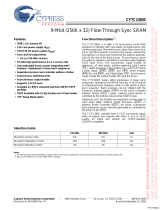 Cypress CY7C1365C User manual
Cypress CY7C1365C User manual
-
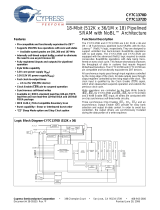 Cypress Perform CY7C1372D User manual
Cypress Perform CY7C1372D User manual
-
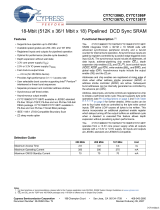 Cypress CY7C1387F User manual
Cypress CY7C1387F User manual
-
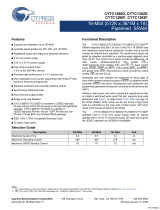 Cypress Perform CY7C1380F User manual
Cypress Perform CY7C1380F User manual
-
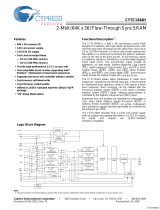 Cypress CY7C1344H User manual
Cypress CY7C1344H User manual
-
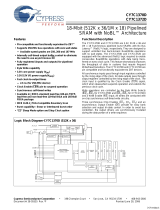 Cypress Perform CY7C1372D User manual
Cypress Perform CY7C1372D User manual
-
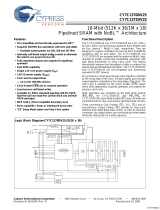 Cypress CY7C1370DV25 User manual
Cypress CY7C1370DV25 User manual
-
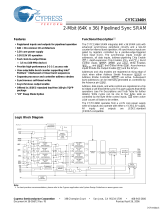 Cypress CY7C1346H User manual
Cypress CY7C1346H User manual
-
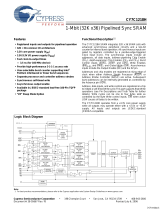 Cypress CY7C1218H User manual
Cypress CY7C1218H User manual
-
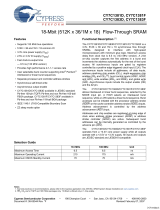 Cypress CY7C1381D User manual
Cypress CY7C1381D User manual






























